
IN THE BEGINNING IT WAS THE SIGN.
Rosinecz Laszlo's Painting
Aspects of the exhibition that took place at "VICTORIA" hall of the Fine Artists' Union of Brasov, Romania, on 22.01.2001
The philosopher Mona Manulea, Doctor of Anthropology, scientific research worker of the Romanian Academy is presenting
In the beginning it was the sign. And this sign has no meaning. We may think now of philosophy, of Plato's metaphysics of the world, in which the world is divided in two parts. On the one hand, there were absolute, unique, eternal ideas; on the other hand, there were the things that meant only some relative, ephemeral copies of these ideas. Therefore, if we make a substitution in Plato's metaphysics of the ideas, and if we replace the word idea with the word sign, we will obtain exactly the pictorial world from there.
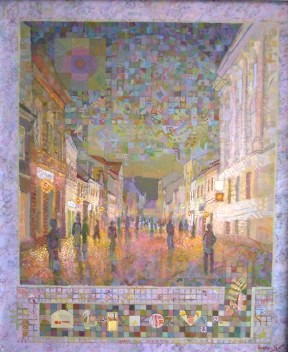
For example, in this masterpiece, bearing in mind that division into two parts, the signs at the top are extremely clearly represented, while at the bottom there are the objects, the things, the people, only as a copy, as a simple reflection of these signs. Nevertheless, the placing of the people in contrast with the signs of the sky leads to an over-terrestrial dimension of this street, Republicii Street. This opposition gives it somehow a cosmic dignity, it places the street as an axis mundi, a centrum mundi. Therefore, this picture is in fact a projection of the heavenly space over the terrestrial space.
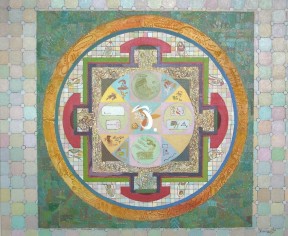
Mr. Rosinecz doesn't use only the signs; there are symbols too, two of them more important than the others. First, a Pythagorean tetrautis symbol, which means in a numerical formula 1+2+3+4; that is
1 = the supreme principle, or the Creator;
2 = the absolute spirit;
3 = the absolute soul;
4 = the matter or the primordial form, the primordial "hille".
This division of the world into 4 (four) parts, which gives it a certain stability, as Mr. Rosinecz states, is a wide spread symbol. It may also be seen in the four elements of the fundamental quartet, in the Hebrew cabala and in the ancient Greek philosophy, in which the ancient Greek philosophers of the nature talked about the four elements: water, air, earth and fire, which the Universe is based upon. In other geometrical shape representations, it is in fact a simple circle, exactly as we see it there, divided into four equal parts by a cross represented by two rectangular diameters.
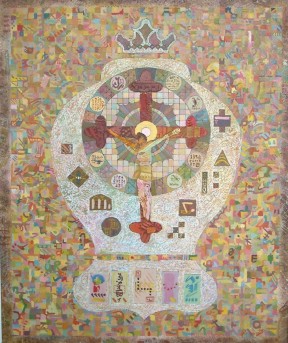
The sign I would like to talk about is that of the fish, which is also a Christical emblem. We can see the fish sigh, a wide spread symbol, present in African, Asian, American Indian culture and even in the Balkan area where they say that the world is based upon 4 big fish or upon 4 whales. This fish sign is in fact here Christ's gnostic emblem "ihtus". ISUS HRISTOS TEU UIOS SOTER.
Of course, Mr. Rosinecz remains faithful to a catholic representation of the Christian symbol. As we may notice if we remember the Byzantine icons, the saints, the Orthodox places into the centre of his metaphysical speech, the transcendental word.
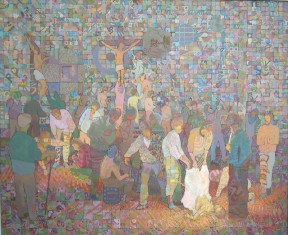
The Byzantine icons are generally populated by almost transparent characters. That must lead us to the transcendent. On the contrary, the Catholic places into the center of his speech the intrinsic element. You can also see the crucifix. The crucifix is a material object that can be touched and therefore we have the idea of communion between man and divinity.
Mr. Rosinecz has a beautiful representation of Jesus Christ on the cross by using a succession of coats, which give the exact image of the cross. Another philosophical idea is that of replacing the earthly crown with an aura-like one, so that it results that Jesus is not only the master of the world over-there, but the master of this world, too.
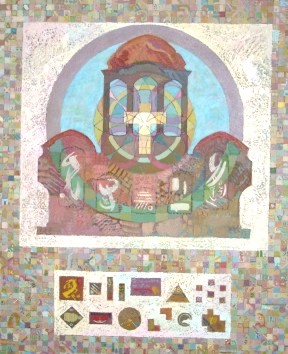
He has a double affiliation, a transcendental affiliation and also an intrinsic one. Hereby the Orthodox aureole is replaced with an earthly crown. This leads us to Janus, a double character that has the earthly scepter and on the other hand the key to the over-terrestrial access. Having the same meaning, Jesus is celebrated by the church, on the Christmas Eve with the next sentence: You, Christ, are David's key and the scepter of Israel's house.
"O clavis Davis et sceptrum domus Israel"